War Stories 24
Enjoy the stories in this section. Some of them may even have been true!! Have a favorite war story you've been relating over the years? Well sit down
and shoot us a draft of it. Don't worry, we'll do our best to correct grammar, punctuation, and spelling before we publish it. to us and we'll publish them for all to enjoy.

the best sleep i never had
by baby huey
On about 20 Oct 70, I (Baby Huey) callsign Medevac 2 was in the middle of
my Aircraft Commander checkride week with Hank Tuell (Okie) callsign Medevac
1 as the evaluator and a crew of Jim Ferguson (Fergie) crew chief, Dan Brady
medic, and Don Tegethoff (Tiny T) the right-side M-60 machine gunner. It
would turn out to be an eventful week with us going through three aircraft
in seven days. Don't look at me and call me "magnet ass," there were four
other soles on our aircraft. It easily could have been one of those other
crewmembers since they were all gung-ho patient savers.
I had flown many times with members of this crew. I knew they were all
professionals and took their jobs seriously, though sophomoric at times when
relief from being on call all the time was needed.
Okie was known to handle the aircraft very well and was a mentor to many
of the Peter Pilots (copilots). I remember being taught a technique where
one could fly the helicopter at great speed and the kicking in the right
pedal and have the helicopter stop almost instantaneously once the
helicopter's broadside presented itself into the wind. It was a technique
that probably overstressed the tail boom but was invaluable to me months
later during a medevac mission. The only problem flying with Okie was that
he always had a quid (ball of chewing tobacco) in his mouth. He would spit
into a Coke can he kept on the helicopter's center console from time to
time. I learned my lesson well flying with Okie. After gaining altitude and
airspeed after an unusually hazardous medevac mission, I reached down to
grab my can of Coke from the center console. As I tipped the Coke can up to
my mouth, I remember for a split second wondering why the Coke was taking so
long to enter my mouth. The cold, gelatinous, spit and tobacco sludge passed
my lips and into my mouth. I thought I was going to throw up so violently my
stomach would be ejected out of my mouth. From that day forward, I drank
Sprite to distinguish my green can from Okie's red can of soda.
Fergie was a natural helicopter mechanic; he knew the aircraft inside and
out. He was not overly boastful about his aircraft knowledge, but the other
maintenance soldiers valued his opinion and direction. If Fergie told one
the aircraft was ready to fly, you could bet no one would be able to find
even the slightest discrepancy. And when not flying as crewchief for one's
aircraft, he was a pleasure to be around on the ground. He was my fellow "chunker"
buddy. We each had M-79 grenade launchers. The M-79 grenade launcher hurled
a half-pound high-explosive projectile 300 yards and capable of punching
through about two inches of steel and inflicting casualties to a radius of
roughly 17 feet. We would periodically challenge each other to some
competition, such as the first one to blow a tree up that falls to the
ground would be the winner. It's amazing what a board soldier can think of
doing for entertainment.
Dan Brady was one of those rare medical emergency personnel that was
super calm under stress. Where other flight medics might overlook a
hard-to-find bullet wound, Dan conducted a head-to-foot body exam of every
patient and never missed an abrasion, laceration, avulsion, or punctuation
wound. When other medics may find it difficult to "stick" a needle into a
severely wounds soldier with lowered blood pressure, Dan could find a viable
vein. He could start an IV even when the helicopter was jumping and shaking
as it flew at max speed to the clearing station.
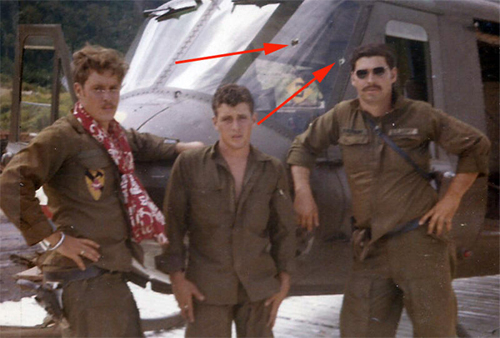
Brady, Ferguson, and Tegethoff with bullet holes in
windscreen
Though Dan was a good-sized flight medic, Tiny was always welcomed to
help the flight medic load patients. Tiny was a big man and could easily
handle his end of a litter load (and then some) that needed to be racked in
the upper position on the litter stack. And woe be the bad guy that stepped
out from behind a hiding place on T's side of the aircraft. Tiny was more
than capable of sending machine gun bullets "downrange."
The crewmember
that had the "most" to lose was Hank Tuell. Our unit had an unwritten policy
that you could stop flying combat missions for the last thirty days of your
tour in Vietnam. You had survived eleven months of combat, and why push your
luck so close to going home. Instead, you would only be tasked with "ash and
trash" missions. Ash and trash missions were considered safe and were
missions such as flying the commander around, mail runs, personnel movement,
medical supply runs, etc. But because of the loss of a few aircraft
commanders, Okie was threatened he could only go home if he trained a
copilot to replace him as aircraft command. And so, it was that Okie was
conducting my aircraft commander checkride when he only had days before his
scheduled departure from Vietnam. Yup, this mission and a couple of other
hairy missions that week were going on when Okie was in Single Digit Midget,
only days away from going home to the "World."
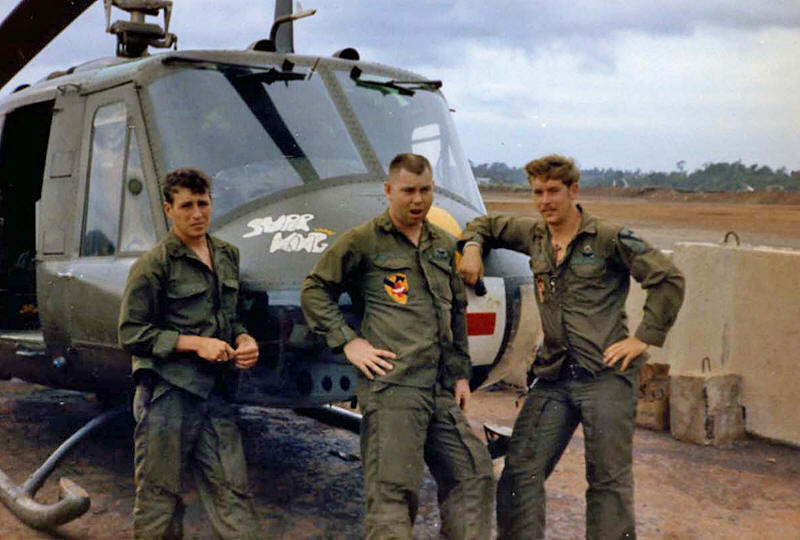
Jim (Fergie) Ferguson, Ron (Baby Huey) Huether, Dan
Brady
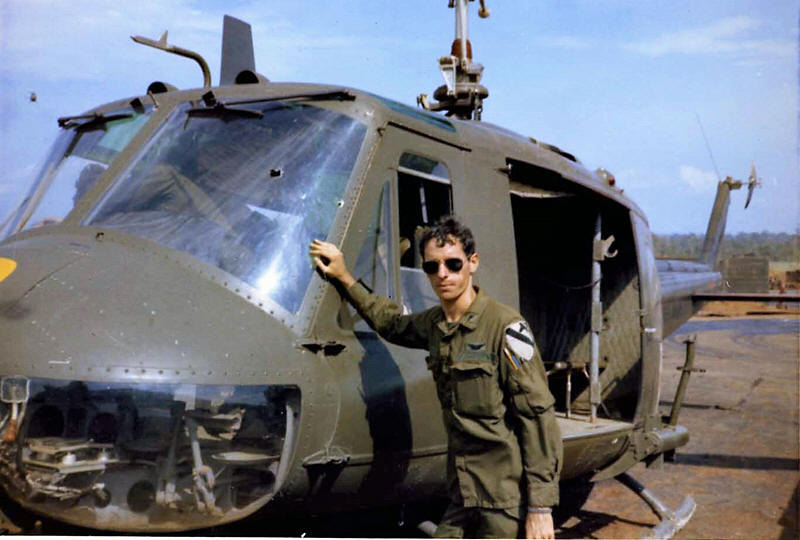
Hank (Okie) Tuell (Notice bullet hole in the
windshield)
We worked from Fire Support Base (FSB) Mace on Chua Chan Mountain's
bottom edge on the east side. The name of the mountain as it was mistakenly
handed down from GI to GI was Nui Ba Ra. A Nui Ba Ra mountain looks like
Chua Chan Mountain, but it's 68 miles north-northwest of FSB Mace. FSB Mace
was forty miles east of Saigon and no longer used as an artillery outpost.
It had become the home for C Company, 15th Medical Battalion, patient
treatment facilities, soldier medics, medical equipment, and rats, lots of
hungry pussy cat-sized rats.
The day before, we had taken enemy fire during a hoist mission, which
damaged the aircraft. Fortunately, the injuries to the crewmembers were
superficial. With no flyable aircraft, we were all looking for a couple of
days of relaxation. But our maintenance officer was "so nice" as to bring us
a replacement aircraft the same day.
We already had a long day of
missions and being on alert playing Blackjack as the sun retreated into the
humid jungle foliage. So, most of us were in our cots when a call came in to
evacuate multiple injured soldiers. One soldier needed urgent evacuation.
Urgent evacuation meant the patient should be picked up and delivered to a
medical facility in less than an hour. That period became known as the
Golden Hour. It could be shown there was a huge rise in survivability if
treatment from a professional staff was administered before the end of that
hour. The clock was ticking.
It was after midnight when we stepped out of our hooch and were enveloped
in dense, grainy fog as thick as a crisp, white blanket of snow on Mount
Everest. I went back into the hooch and called the Radio Telephone Operator
(RTO) and told him we were fogged in and unable to attempt the mission. The
weather condition outside was what aviators call zero-zero. The bottom of
the cloud layer (fog) was zero feet off the ground, and visibility was zero
feet in front of you. It was a weather condition I relished taking off in
later in my aviation career when I had thousands of flight hours. But now, I
was six months after graduation from flight school.
I hoped to find how local the fog bank was, so I asked the RTO to
question the unit to see if they were in a fog. A few minutes later, the RTO
relayed a message our urgent patient would not survive the night. He also
added that the unit said they "could see the stars at their location." I
mistakenly thought the unit was telling me there was no fog at their
location.
Okie and I huddled together and discussed how to go about attempting this
mission or maybe canceling it. We discussed that maybe the fog could be
localized, and if so, we might ground taxi our Medevac out to the dirt road
running by our encampment. And from there, we may be able to continue ground
taxing to the edge of the fog. Since the UH-1H helicopter doesn't have
wheels, a ground taxi is conducted by getting the aircraft light on its
skids and then slowly moving the helicopter, so the skids drag along the
ground.
When we reached the perimeter concertina wire, we'd perform a fast "hop"
over the wire and back down on the road. Concertina wire is named after the
musical instrument, and its expanding and contracting bellows like an
accordion. Unlike barbed wire with its pointed barbs at regular intervals,
the concertina wire has sharp blades that can slice deep into one's flesh.
Or, if the wire became entangled in our helicopter's skids, would cause our
chopper to crash.
After reaching the road, we hoped to continue ground taxing east along
the dirt road until we were out of the fog. Since the unit was in contact
with the enemy, Blue Max cobra attack aircraft were also alerted to escort
us and provide cover fire for our mission. Although the Blue Max cobra
attack aircraft had already told us they would not be escorting us, Medevac
was known for doing everything possible to complete a mission, no matter how
hazardous the situation. The plan was a bit dicey, okay a lot dicey, but it
just might work and possibly save a soldier's life. In Medevac, we made this
kind of decision often.
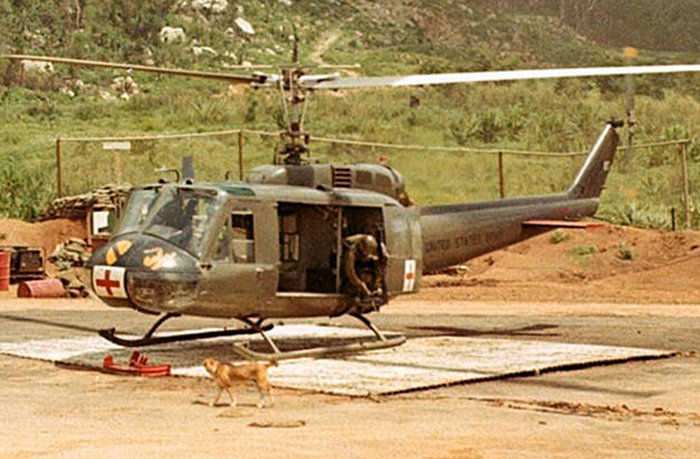
Deros at FSB Mace
We had a mascot in our hooch, a feminine looking dog named Deros. Her
name was a play on the acronym DEROS, which stood for Date of Estimated
Return from Overseas – the date you were due to leave Vietnam. Deros would
accompany us on missions and saved more than one life by licking a wounded
soldier and keeping him awake until we arrive at the clearing station. A
clearing station is a small medical facility with a physician. After a
while, some of us noticed Deros only jumping on board when it was a "cold"
mission. A "cold" mission generally meant the soldier was injured without
contact with the enemy. Typically, cold missions were broken legs, sprained
ankles, accidental stabbing, etc. But when the mission was a "hot" mission,
meaning the ground unit was in contact with the enemy, Deros would stay back
in the hooch. How she could discern cold missions from hot missions was a
doggie mystery—a good question for Cesar Milan, the Dog Whisperer. So even
if we were told the mission was cold, we'd look to see if Deros wanted to go
on the mission. If she didn't, and she was phenomenally accurate, sure
enough, the bad guys would be shooting at us as we conducted the rescue.

Huey dashboard
It was then that Okie made the one crucial decision that made the
difference between crashing our Medevac with death or injury to all of us or
completing the mission without incident. The aircraft commander's customary
position in a helicopter was the left seat. Since I was being evaluated to
become an aircraft commander, I was being evaluated in the left seat. The
pilot (copilot) "always" occupied the right seat. But the instrument panel's
right side has many more and larger gauges indicating orientation (left,
right, up, and down) and gauges for altitude and the rate of climb or
descent. Since I had gone through instrument training while in flight school
and Okie hadn't, he told me to climb into the right seat. I now had all the
instruments I might need for flying in the clouds, or fog as it was. That
one decision turned out to be a lifesaver for our crew.
We boarded the helicopter, and everyone took their position for what was
going to be a hair-raising mission. A casual look around confirmed we were
going to have trouble because Deros stayed in our hooch. Okie got the
helicopter light on the skids and slowly turned it, so we were facing north.
Then he began dragging the helicopter's skids along the dirt toward where we
thought the concertina wire was located. Since we could only see a yard or
two in front of us at best, we were all worried about possibly snagging
commo wire strung across the road when we hopped over the concertina wire.
If the wire wrapped around the control tubes, we would be unable to control
the helicopter. We didn't even want to entertain what would happen next.
After several minutes, we finally reached the dirt road, and Okie turned
our helicopter east-southeast as he continued ground taxing. We hadn't gone
but another fifty feet down the dirt road when the helicopter hit a bump. We
bounced (probably) a couple of feet in the air, and we could no longer see
the road or anything around us. Though the stars were out, it was pitch
black like when one takes a cavern tour, and the guide turns off the cavern
lights. We were in an impenetrable fog, and it was slightly after midnight
and very dark.

Vietnam fog
The next series of events probably took less than a minute, but it was
sheer terror. I remember looking through the Plexiglas chin bubble located
at my feet and not seeing the road or anything else. Then briefly, ever so
briefly, I saw what appeared like grass possibly on the road's edge passing
quickly in a forward direction. I remember thinking, in nanoseconds, if the
grass looked as if it was moving forward, that meant we were traveling
backward! We were about to crash.
I yelled for Okie to climb at the same
time, Okie yelled, "You've got the aircraft, climb!" and transferred the
controls to me. I immediately took the controls and shifted my gaze to the
dashboard instruments while initiating an instrument take-off (ITO) climb.
And, poof, at less than one hundred feet of altitude, we were out of the
fog. We had arrived at the most serene, tranquil, pitch-black darkness only
dimly lit by the distant twinkling stars. Other than five significantly long
exhalations, the crew didn't say a single word. Our whole area of operation
(AO) was blanketed with the most beautiful contiguous fog layer, with the
only thing protruding from the fog being the surrounding mountains and
ridgelines. Not another ground navigational aid, town or aircraft could be
seen. Thankfully, Okie had put me in the right seat and prayed I knew how to
keep the helicopter upright in the clouds.
Immediately our training returned, and we were on our way to the pick-up
location. We flew east following a road that periodically peeked out at us
from the fog bank when we were directly over it. Then we followed another
road northwest putting us in the general area of our patient evacuation.
While contacting the ground unit to check the patient's status and the
enemy situation, we were ordered by the unit's battalion commander to land
on a small hilltop for a situational awareness briefing. Upon landing on
this hilltop, we were informed the unit's location was somewhere in the fog
below. Further, we were briefed that the American soldiers had earlier been
establishing their night perimeter when they had accidentally bumped into an
enemy unit setting out their night defenses. Both sides retreated into the
fog-clogged night. In the commotion, the American unit had dispersed in all
directions leaving most of their rucksacks and ammunition. Suddenly, the
mission became more critical because if the enemy found out most of our
soldiers only had their rifles but no additional ammunition, our soldiers
may be slaughtered one by one as they ran out of bullets.
When we landed on the hilltop, soldiers started arriving at our
helicopter with boxes of ammunition, grenades, and sundry supplies needed to
assist the unit from getting overrun. Since Okie had not yet blessed me with
being an aircraft commander (thank God), he jumped from the left seat. He
walked quickly to the Tactical Operations Center (TOC) to confer with the
battalion commander. The guys in the back (GIBs) stopped the soldiers from
loading the ammunition on our aircraft because, technically, medical
personnel and Medevac aircraft are neutral in a conflict. It's a strange
situation, not realized by many folks. Our Medevac and its crew were
technically neutral in an armed conflict. Our only job was to save lives,
any life on either side of a conflict. So, yes, there were times that we
evacuated Viet Cong and North Vietnam Army soldiers that had been wounded.
The only difference in care given was that a wounded American soldier
received medical treatment before an enemy soldier. We're not supposed to
assist either side except for medical evacuation and medical supplies.
After an agonizing few minutes waiting in the dark, Okie returned and
told us to let the soldiers load the ammunition. It was a moment where
following the rules would save one soldier while the remaining platoon may
be slaughtered. Or does one allow for our soldiers' resupply and potentially
snatch all the platoon members from the hands of death? It was decided we'd
break the rule and ask for forgiveness later.
After our aircraft was loaded, we left the hilltop for another fun-filled
thirty minutes. You see, as the straggler soldiers worked on finding each
other and establish some semblance of a fighting force, they didn't know
their location. Our helicopter had an FM radio with a homer capability that
would point a needle in a gauge toward the transmitting radio. That's the
good news, but the less than good news is that once the gauge indicated you
were in the vicinity of the transmitting radio's location, it was
approximate since the FM homer was notoriously inaccurate. And we could
only see anything on the ground when we were directly over it.
Okie started flying a grid pattern and going back and forth. The unit on
the ground would radio us telling us if the helicopter's noise was sounding
closer or further away. Eventually, we were told we were directly over the
unit. Sure enough, we could look down through the fog layer and see the
soldiers in a small opening in the jungle.
My job was to adjust artillery onto the enemy soldiers' suspected
location. Okie was flying the helicopter, and the GIBs were overseeing the
dropping of the supplies and hoisting up the patient. First, the GIBs threw
down a semi-rigid poleless litter so the platoon members could begin wrapping
the patient in the poleless litter. The semi-rigid poleless litter is a canvas
backboard with sewn-in wooden slats and a large ring on the end. By
strapping the patient into the poleless litter and clipping the hook from the
aircraft's hoist to the ring, we were able to winch a patient vertically.
This allowed the patient to come up through a small opening in the jungle
canopy with minimal contact with the tree limbs.
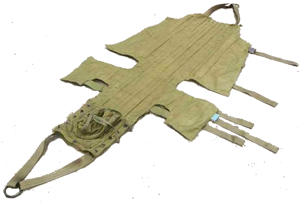
Semi-ridged Poleless Litter
After the poleless litter was dropped, the guys on the ground were warned
to stand clear of where it landed because the next things falling would be
their supplies and ammunition. Then the GIBs started pushing out the
supplies. Okie continued maintaining a stationary hover just above the
jungle canopy as the last of the ammo was dropped from the helicopter. Then
Dan Brady ran the hoist cable down to retrieve the critical patient up to
our Medevac's safety.
Ah yes you say, brother, you Medevac guys have some unforgettable
missions. But alas, we still needed to fly another thirty miles to the
nearest treatment facility. A patient would typically be flown from the
point of injury to our clearing station (aid station with a doctor). But we
couldn't see our clearing station at FSB Mace through the fog and darkness.
I contacted Queen Tonic, the callsign for the medical regulator in our
area. The medical regulator's function is to make sure the patient is flown
directly to the medical treatment facility best able to give the care
required. The destination may or may not be the one nearest the site of
injury. The decision as to the proper destination hospital was based on
several factors. The distance was less important than time; the objective
was to reduce the time between injury and definitive treatment to the
minimum. Information based on the preliminary in-flight evaluation of the
injury, the patient's condition, knowledge of existing surgical backlogs,
and the over-all casualty situation were other considerations. The medical
regulator would inform the receiving hospital by radio of our estimated
arrival time, the nature of the casualty, and any special reception
arrangements. Thus, the receiving hospital would have everything ready to
receive our patient and begin definitive surgical care.
We started flying south at about 1500 feet over the most beautiful carpet
of fog as Brady worked diligently trying to save the patient. Upfront Okie
and I were hoping for a break in the fog so we could land and our patient
could receive more definitive care. We initially called Air Force GCI
(Ground Control Interception) callsign Paris Control at Tan Son Nhut Air
Force Base in Saigon for some radar navigational assistance. We had so few
visual cues because of the fog, and we knew their radars also monitored all
aircraft's flight positions within their range. In mild weather, we used
Paris Control to give us a direct heading to our patient's location. In
harsh weather, they did advisory radar flight following for guys like us.
After receiving a vector to our patient, we'd radio them as we were about to
conduct our combat approach. If we got shot down, at least Paris Control had
a "blip" of our last known location. They were also tasked with several
other responsibilities, such as providing aid in the event of an inflight
emergency. We considered the possibility of not finding a suitable landing
place before fuel exhaustion an emergency.
We probably got ahold of some nineteen-year-old airman who had been sound
asleep and asked for radar vectors to the large airbase at Bien Hoa.
Usually, the radar operator would have us do a couple of turns on his
command to identify our aircraft positively. As it turned out, we were the
only aircraft aloft, so positive identification was easy – the only blip on
the radar screen was us. All the other aircraft had remained on the ground
due to the thick fog.
Fortunately, all the worrying about how to descend through the fog was
for naught. As we arrived close to Bien Hoa, we could see the runway lights
through the fog and made an uneventful descent and landing.
Queen Tonic, the medical regulator, had coordinated for an ambulance to
meet us at the airfield and take our patient to one of Long Binh's
hospitals. With the patient in the care of the hospital folks, it was time
to decide on staying at Bien Hoa or attempt to return to our AO. It was an
easy decision as we never wanted to leave our AO without Medevac support. We
departed Bien Hoa and climbed about the fog with the hopes we'd be lucky and
find a "sucker hole" close to FSB Mace so we could descend and land. As it
turned out, the "lucky Gods" had gone to sleep, and it was going to be near
impossible to make a safe descent through the fog layer at night. But there
was a "sucker hole" above the town of Xuan Loc. With over half our fuel
depleted, we elected to land on an unused soccer field and spend the night
there.
Here we were, in the middle of "bad guy" territory, with only our
personal weapons and two aircraft weapons to defend against attack. We had
made it back to just five miles short of FSB Mace. But one final decision
had to be made. Does one attempt to catch a few winks of much-needed sleep
laying on a litter with no mosquito net to ward off the gigantic local
mosquitos, or does one pull a heavy thick wool Army blanket over your body,
thwarting the mosquitos and suffer the heat, which is still torrid even
after the sun goes down? You guessed it, neither decision was favorable, and
so we suffered for a few hours until the sun came up and burned off the fog.
It was just another day or night as it was, in the life of a Medevac
crew hell-bent on saving lives. Thinking back over the mission and how tired
we were, it was the best sleep I never had.
[ Return To Index ]